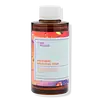What's inside
What's inside
 Key Ingredients
Key Ingredients

 Benefits
Benefits

 Concerns
Concerns

No concerns
 Ingredients Side-by-side
Ingredients Side-by-side

Water
Skin ConditioningGlycerin
HumectantNiacinamide
Smoothing1,2-Hexanediol
Skin ConditioningPropanediol
SolventArbutin
AntioxidantBetaine
HumectantGlycyrrhiza Glabra Root Extract
Bleaching3-O-Ethyl Ascorbic Acid
Skin ConditioningEthylhexylglycerin
Skin ConditioningCarbomer
Emulsion StabilisingTromethamine
BufferingTrisodium Ethylenediamine Disuccinate
Theobroma Cacao Seed Extract
AntioxidantSodium Hyaluronate
HumectantDextrin
AbsorbentTocopherol
AntioxidantWater
Skin ConditioningGlycolic Acid
BufferingButylene Glycol
HumectantLactococcus Ferment Lysate
Skin ConditioningSodium Hydroxide
BufferingLactic Acid
BufferingSodium Hyaluronate
HumectantAgar
MaskingGlycerin
HumectantTremella Fuciformis Sporocarp Extract
AntioxidantCamellia Sinensis Leaf Extract
AntimicrobialVaccinium Angustifolium Fruit Extract
Skin ProtectingCurcuma Longa Root Extract
MaskingCichorium Intybus Root Extract
MaskingYogurt Extract
Skin ConditioningCarrageenan
Betaine
HumectantGlucose
HumectantLinum Usitatissimum Seed Oil
PerfumingXanthan Gum
EmulsifyingPotassium Sorbate
PreservativeDisodium EDTA
Sodium Chloride
MaskingSodium Benzoate
MaskingPolysorbate 20
EmulsifyingTetrasodium EDTA
Ethylhexylglycerin
Skin ConditioningPhenoxyethanol
PreservativeWater, Glycolic Acid, Butylene Glycol, Lactococcus Ferment Lysate, Sodium Hydroxide, Lactic Acid, Sodium Hyaluronate, Agar, Glycerin, Tremella Fuciformis Sporocarp Extract, Camellia Sinensis Leaf Extract, Vaccinium Angustifolium Fruit Extract, Curcuma Longa Root Extract, Cichorium Intybus Root Extract, Yogurt Extract, Carrageenan, Betaine, Glucose, Linum Usitatissimum Seed Oil, Xanthan Gum, Potassium Sorbate, Disodium EDTA, Sodium Chloride, Sodium Benzoate, Polysorbate 20, Tetrasodium EDTA, Ethylhexylglycerin, Phenoxyethanol
 Reviews
Reviews

Ingredients Explained
These ingredients are found in both products.
Ingredients higher up in an ingredient list are typically present in a larger amount.
Betaine is a common humectant (a substance that promotes retention of moisture). It's known to be gentle on the skin and can help balance hydration.
This ingredient is best for improving hydration and soothing irritated skin. Studies also show it helps even out skin tone.
Fun fact: Betaine is naturally created in the skin and body. The kind found within cosmetic products can be either plant-derived or synthetic.
Another name for betaine is trimethylglycine.
Learn more about BetaineEthylhexylglycerin (we can't pronounce this either) is commonly used as a preservative and skin softener. It is derived from glyceryl.
You might see Ethylhexylglycerin often paired with other preservatives such as phenoxyethanol. Ethylhexylglycerin has been found to increase the effectiveness of these other preservatives.
Glycerin is already naturally found in your skin. It helps moisturize and protect your skin.
A study from 2016 found glycerin to be more effective as a humectant than AHAs and hyaluronic acid.
As a humectant, it helps the skin stay hydrated by pulling moisture to your skin. The low molecular weight of glycerin allows it to pull moisture into the deeper layers of your skin.
Hydrated skin improves your skin barrier; Your skin barrier helps protect against irritants and bacteria.
Glycerin has also been found to have antimicrobial and antiviral properties. Due to these properties, glycerin is often used in wound and burn treatments.
In cosmetics, glycerin is usually derived from plants such as soybean or palm. However, it can also be sourced from animals, such as tallow or animal fat.
This ingredient is organic, colorless, odorless, and non-toxic.
Glycerin is the name for this ingredient in American English. British English uses Glycerol/Glycerine.
Learn more about GlycerinSodium Hyaluronate is hyaluronic acid's salt form. It is commonly derived from the sodium salt of hyaluronic acid.
Like hyaluronic acid, it is great at holding water and acts as a humectant. This makes it a great skin hydrating ingredient.
Sodium Hyaluronate is naturally occurring in our bodies and is mostly found in eye fluid and joints.
These are some other common types of Hyaluronic Acid:
Learn more about Sodium HyaluronateWater. It's the most common cosmetic ingredient of all. You'll usually see it at the top of ingredient lists, meaning that it makes up the largest part of the product.
So why is it so popular? Water most often acts as a solvent - this means that it helps dissolve other ingredients into the formulation.
You'll also recognize water as that liquid we all need to stay alive. If you see this, drink a glass of water. Stay hydrated!
Learn more about Water